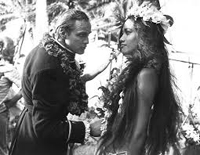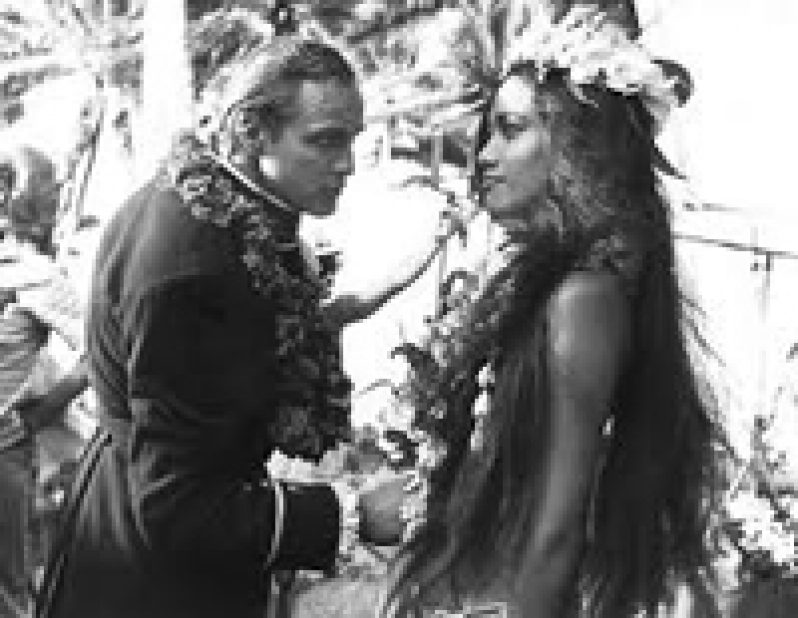CENTRAL to Brando’s first film roles is his gripping portrayal of young men who seem to idolize being difficult, or in love with the emotion of anger, and even the power of inflicting fear in others.
 In ‘THE WILD ONE’ of 1953, a film which caused a sensation among American youths upon release, not only because of Brando’s role as the leader of a motorcycle gang terrorizing small towns, but also his style of dress, Brando is asked by one of his female targets:
In ‘THE WILD ONE’ of 1953, a film which caused a sensation among American youths upon release, not only because of Brando’s role as the leader of a motorcycle gang terrorizing small towns, but also his style of dress, Brando is asked by one of his female targets:
“What are you rebelling against, Johnny?” To which he replies: “What you got?” His point is taken: He is on the lookout for the slightest provocation of his potential negative reactions. Such roles are not as unjustified as they seem at first, when we look closer at the behaviour of those they react to; and this is the above average value of both Brando’s rebellious roles and the overall quality of the films they are contained in.
Method acting lessons
Brando’s ‘method acting’ style of character representation lays bare, or brings to intelligent clarity, the wider social context in which it is placed. His negative egotism, as in ‘ A STREETCAR NAMED DESIRE’; ‘The Wild One’; ‘VIVA ZAPATA’; ‘ON THE WATERFRONT’;‘ONE EYE JACKS’, etc helps bring to the surface the denied positive or morally responsible values submerged within him.
What makes ‘The Wild One’ a memorable humane Brando role is his eventual giving in to a girl’s innocence he denies at first, projecting unto her a prejudicial attitude towards him, simply because of the way he looks and lives. His eventual about turn, or softening, at the film’s end comes like a result of questioning what is considered ‘normal’ manners or etiquette, rather than a slavish acceptance of its a priori value, based solely on social custom or convention.
The unorthodox Brando role is really a ‘method’ that goes beyond simply inhabiting a character, or displaying a technical skill, but rather exposes and explores a path to moral conciliation. It is individual and social identity well earned.
Brando’s creative freedom
Much of Brando’s fame gained from his roles is really indebted to the topic of the films he chose to do, also its directors. Indeed, Brando is one of those rare actors who clearly acted what he wanted to act, not what was chosen for him. This certainly accounts for some of his prestige as one of America’s finest actors.
In ‘Viva Zapata’, it is director Kazan’s critical exposure of how the opinions of social or political leaders can be used and abused by their own power-drunk followers, which both Brando and his right-hand man, played memorably by young Anthony Quinn, act out for our benefit. The same theme occurs, but in reverse, in Kazan’s ‘On The Waterfront’. This time, it is the bullying waterfront crime boss, played by Lee J. Cobb, who corrupts and misleads Brando, via his brother’s involvement with his racket. Brando revolts when he finds out how he has been deceived, and brilliantly demonstrates, via ‘method acting’, Kazan’s belief in the power of individual moral choice in ‘On the Waterfront’, so richly deserving of his first Oscar for a convincing performance.
The real Brando
It is questionable whether Brando’s ability to vividly portray a social ‘type’ found in motorcycle gangs among waterfront workers in the American ‘South’, in Nazi uniform, in the Imperial British Navy, or the Italian underworld, etc, comes from his learning of Kazan’s ‘method acting’, or from his extra real-life social study of such characters.
In the early 50s, at the time of making ‘GUYS AND DOLLS’ with co-star, Frank Sinatra, Brando distanced himself from those early ‘social message’ films, and was so cooled out and gregarious, MGM’s founder, Samuel Goldwyn, bought him an expensive sports car. At that time, he began to identify with Beatnik culture, which was growing as the American counter-culture.
Like James Dean, he could be found in the cafes and nightclubs of LA, or New York’s Harlem, playing bongos with its jazz musicians, poets, dancers, and theatre people, many of whom were Afro-Americans, male and female.
By 1959, this Beatnik experience and lifestyle would influence his role and personal performance in ‘THE FUGGITIVE KIND’, one of his rare films, directed by the stylish, off-beat director, Sidney Lumet.
Artistic reputation
Brando’s artistic reputation as a character actor solidified in 1958, with his performance as a somewhat humane World War II German officer in ‘THE YOUNG LIONS’, a gem of a film, co-starring two of Hollywood’s finest actors, Montgomery Clift and Dean Martin, who, under the earlier blacklisted director, Edward Dmytryk, helped him prove his controversial originality with this film.
The popularity of Brando as an actor also had to do with his consistent ability to make a fashion statement, via period costumes, which foresaw the emerging 1960s Hippie counter-culture use of costume fashion, picked up by pop groups like The Beatles, Procul Harum, Led Zeppelin, The Jimi Hendrix Experience, Jefferson Airplane, etc.
In 1961, Brando’s lengthy ‘One Eye Jacks’, in which he starred as well as directed, proved how beautifully he could dress. This is Brando looking his best ever in Western clothes, which harks back to Robert Taylor in his 1950s colour Westerns.
‘One Eye Jacks’ is one of Brando’s greatest demonstrations of reformed wayward character within outrageous content. The film was promptly disliked by some critics for its honesty, no doubt.
Another of his best films would come in 1962: ‘MUTINY ON THE BOUNTY’, directed by Lewis Milestone, a veteran radical Hollywood director, who not only allowed Brando to explore an unconventional moral identity, but to discover the island of Tahiti, which influenced his love life.
‘THE CHASE’ of 1966, on the other hand, directed by Arthur Penn, brought back the Brando whose thoughtful mannerisms, silence, and low voice, said Cool out! Relax!, Think! in one of the best films of his career. If anyone thought Brando had explored all his acting skills by 1970, ‘THE GODFATHER’ of 1971, under Francis Coppolas’s direction, made Brando stuff cotton wool in his jaws to effect the speech and behavior of an aging Don. Brando’s snubbing of his second Oscar for this film was his way of saying, acting was not a celebrity reward or lifestyle for him, but the exploration of human identity via the opportunity offered by art.



.jpg)








